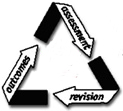Assessment Brief #102 - Aligning Assessment with Professional Accreditation Review in Architecture+Interior Design

November 2018
Aligning Assessment with Professional Accreditation Review in Architecture+Interior Design
For years, the Architecture (ARC) program faculty have engaged in two separate assessment processes—one for their accrediting bodies and another for the University. This approach was neither effective nor efficient. Recently, the Architecture+Interior Design department revised its University assessment plan to better align with the rigorous assessment process required by their accreditation agencies.
Both programs are externally reviewed on an ongoing basis: Architecture programs by the National Architectural Accrediting Board (NAAB) and Interior Design programs by the Council for Interior Design Accreditation. Because numerous courses in the BA and M. Arch programs are stacked courses, a single assessment plan serves both architecture programs.
Accreditation for the Architecture programs occurs on an eight-year cycle and involves preparation of an Architecture Program Report (a self-study) and a Visiting Team Report (a peer review based on a multi-day site visit by a NAAB-appointed team of educators, practitioners, regulators, and students). During their visit, the team carefully reviews student work, focusing on specified learning outcomes and interviews of faculty, staff, and students on their perceptions of their learning and the program quality.
The team then develops a comprehensive report that includes a detailed assessment of the student learning outcomes, articulates which outcomes are being met, and identifies areas of concern. Deficiencies must be addressed prior to the next review, and progress reports are also required in the intervening years.
Because of the thorough and high quality nature of this review, the program faculty decided to use the work and findings of the accreditation review team as a centerpiece of their revised assessment plan. In the intervening years between each team visit, faculty focus on understanding and addressing one or more deficiencies or areas of concern identified by the accreditors. To address a concern, the faculty might revise a core course, develop new assignments for existing courses, engage in faculty development related to an outcome, or implementing a discrete assessment project relating to an area of concern.
Using this approach, the program now follows an eight-year assessment cycle that includes the following steps:
- Year 1: Accreditation Visit and submission of the accreditor's report for the University's assessment report.
- Year 2: Internally review findings of accreditation visit, and focus on one area of concern identified in accreditation report by developing and implementing one or more strategies for improvement related to that area of concern. Create annual report that summarizes actions taken to design and implement improvement strategies.
- Year 3: Track progress of the strategies for improvement identified the previous year, and focus on a new area of concern. Develop/implement strategies for improvement related to that concern. Create annual report that summarizes action taken.
- Year 4-6: Same as year 3, only the focus is on a new area of concern. Create annual report that summarizes actions taken.
- Year 7: Prepare for next accreditation visit by creating a self-study and reflecting on progress. Create annual report that draws from the key parts of the self-study focused on assessment.
- Year 8: Accreditation Visit and submission of the accreditor's report for the University's annual assessment report.
- Year 9: Create new assessment plan that builds on accreditor's findings. Submit this new plan instead of the annual report.
The Interior Design program follow a similar plan on a six-year cycle.
Professors Mary Rogero and Mary Ben Bonham, who are the creators of this assessment plan, believe that it will be beneficial because of the synergy between the assessment efforts. "The quality of our internal assessment activities is actually one of the criteria looked at by our external accreditors," says Bonham. "The dovetailing of our internal and external assessments helps us streamline the process on both fronts."

